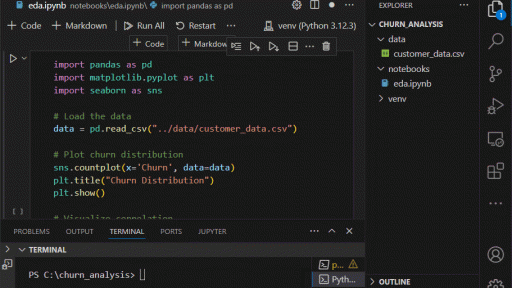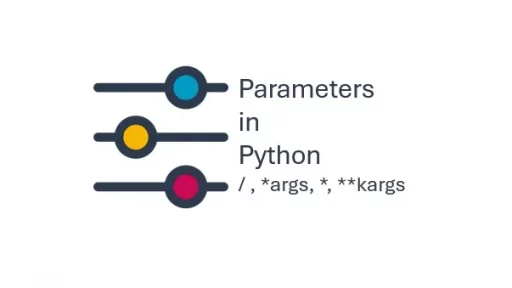Python offers tools that make repetitive tasks manageable. Among these are loops and iterative tools. Whether you need to iterate through a sequence, check conditions repeatedly, or handle a data-heavy task efficiently, these tools have you covered.
This guide will introduce you to Python’s looping mechanisms, provide examples, and clarify when to use each one.
Types of Loops in Python
1. For Loops
The for loop is ideal when you know the sequence or range of items to iterate through. It works with lists, tuples, dictionaries, sets, and strings.
Example: Iterating Over a List
In loops_demo.py:
# loops_demo.py
# List iteration
fruits = ["apple", "banana", "cherry"]
for fruit in fruits:
print(f"I love {fruit}")When to Use:
Use a for loop when working with known collections or ranges, such as processing a list of items or generating sequences.
2. While Loops
The while loop is condition-driven. It continues to execute as long as a given condition evaluates to True.
Example: Counting to Ten
# loops_demo.py
# Counting with a while loop
count = 1
while count <= 10:
print(f"Current count: {count}")
count += 1When to Use:
Choose while loops when the number of iterations isn’t fixed or depends on runtime conditions, such as user input or dynamic computations.
3. Infinite Loops
An infinite loop runs forever unless explicitly broken. While it’s not a separate type, it’s a behavior achieved using while loops.
Example: Infinite Loop with Break
# loops_demo.py
# Infinite loop with user input
while True:
user_input = input("Enter 'stop' to end: ").strip().lower()
if user_input == "stop":
print("Loop ended.")
break
print(f"You entered: {user_input}")When to Use:
Infinite loops are useful in event-driven programs, such as servers or games. Always include an exit condition (like break) to prevent unintended behavior.
Enhancing Loops with Control Statements
1. Break
The break statement exits a loop prematurely.
Example: Breaking a Loop
# loops_demo.py
# Exit on specific condition
for number in range(10):
if number == 5:
print("Breaking loop at 5")
break
print(number)When to Use:
Use break when you want to terminate a loop based on a specific condition.
2. Continue
The continue statement skips the rest of the code in the current iteration and moves to the next iteration.
Example: Skipping Odd Numbers
# loops_demo.py
# Skipping odd numbers
for number in range(1, 11):
if number % 2 != 0:
continue
print(f"Even number: {number}")When to Use:Continue is helpful when you need to bypass certain iterations without breaking the loop.
3. Else with Loops
In Python, loops can include an else clause. It executes after the loop finishes, unless the loop is terminated with a break.
Example: Loop Completion
# loops_demo.py
# Checking loop completion
for number in range(5):
if number == 6:
break
else:
print("Loop completed without break")When to Use:
The else block is great for handling logic when a loop completes naturally.
Choosing the Right Loop
- For Loop:
Use when iterating over a collection, range, or generator. It’s clean and concise for most scenarios. - While Loop:
Use when the termination condition depends on runtime evaluation. It’s flexible but requires careful condition management to avoid infinite loops. - Infinite Loop:
Use when building systems that require constant execution, such as server processes. Ensure you have a reliable exit condition.
In addition to loops, Python provides a variety of tools and techniques to handle repetitive tasks. These tools complement or even replace traditional loops in certain scenarios.
1. List Comprehensions
A list comprehension is a concise way to create lists by iterating over an iterable and applying an optional condition or transformation.
Example: Squares of Numbers
# loops_demo.py
# Generate a list of squares
squares = [x ** 2 for x in range(10)]
print(squares)Why Use It?
List comprehensions are more compact and often faster than traditional for loops for creating new lists.
2. Generator Expressions
Generator expressions are similar to list comprehensions but produce values one at a time using an iterator, instead of creating the entire list in memory.
Example: Sum of Squares
# loops_demo.py
# Calculate sum of squares using a generator
sum_of_squares = sum(x ** 2 for x in range(10))
print(sum_of_squares)Why Use It?
Generators are memory-efficient and suitable for handling large datasets or infinite sequences.
3. The map() Function
The map() function applies a specified function to each item in an iterable.
Example: Convert Strings to Uppercase
# loops_demo.py
# Convert a list of strings to uppercase
names = ["alice", "bob", "charlie"]
uppercase_names = map(str.upper, names)
print(list(uppercase_names))Why Use It?map() is a functional programming tool that avoids explicit loops for applying a function to all elements of an iterable.
4. The filter() Function
The filter() function returns elements from an iterable that satisfy a given condition.
Example: Filter Even Numbers
# loops_demo.py
# Filter out odd numbers
numbers = range(10)
even_numbers = filter(lambda x: x % 2 == 0, numbers)
print(list(even_numbers))Why Use It?filter() is useful when you need to extract elements based on a condition without writing a full loop.
5. The reduce() Function
Part of the functools module, reduce() applies a function cumulatively to the items of an iterable, reducing it to a single value.
Example: Multiply All Numbers
# loops_demo.py
from functools import reduce
# Multiply all numbers in a list
numbers = [1, 2, 3, 4]
product = reduce(lambda x, y: x * y, numbers)
print(product)Why Use It?reduce() simplifies cumulative operations, like summing or multiplying a sequence of values.
6. The itertools Module
The itertools module provides a collection of tools for creating and manipulating iterators, including infinite sequences, combinations, and permutations.
Example: Generating Permutations
# loops_demo.py
from itertools import permutations
# Generate all permutations of a list
items = [1, 2, 3]
all_permutations = list(permutations(items))
print(all_permutations)Why Use It?itertools is perfect for complex looping needs, such as generating combinations, Cartesian products, or iterating over infinite sequences.
7. Set and Dictionary Comprehensions
Similar to list comprehensions, these allow you to create sets and dictionaries in a concise manner.
Example: Create a Dictionary from a List
# loops_demo.py
# Generate a dictionary with numbers as keys and their squares as values
squares_dict = {x: x ** 2 for x in range(5)}
print(squares_dict)Why Use It?
They offer a clean and readable way to create dictionaries and sets programmatically.
8. Recursive Functions
Recursion allows a function to call itself to solve a problem in smaller subproblems, often eliminating the need for explicit loops.
Example: Factorial Calculation
# loops_demo.py
# Recursive function to calculate factorial
def factorial(n):
if n == 0:
return 1
return n * factorial(n - 1)
print(factorial(5)) # Output: 120Why Use It?
Recursion is ideal for problems that can be broken down into smaller, repetitive tasks, such as tree traversal or solving mathematical problems.
9. Built-in Functions
Python provides built-in functions like sum(), max(), min(), and all() that handle repetitive operations without requiring explicit loops.
Example: Sum of a List
# loops_demo.py
numbers = [1, 2, 3, 4, 5]
total = sum(numbers)
print(total)Why Use It?
These functions are efficient and concise alternatives to looping.
10. Asyncio for Concurrent Tasks
The asyncio module handles asynchronous programming, allowing tasks to run concurrently instead of sequentially.
Example: Running Multiple Async Tasks
# loops_demo.py
import asyncio
async def say_hello(name):
await asyncio.sleep(1)
print(f"Hello, {name}")
# Run tasks concurrently
async def main():
await asyncio.gather(say_hello("Alice"), say_hello("Bob"))
asyncio.run(main())Why Use It?
Asynchronous tools are essential for I/O-bound tasks like API calls or database operations.
Thank you for reading this article. I hope you found it helpful and informative. If you have any questions, or if you would like to suggest new Python code examples or topics for future tutorials, please feel free to reach out. Your feedback and suggestions are always welcome!
Happy coding!
C. C. Python
You can also find the article at Medium.com


